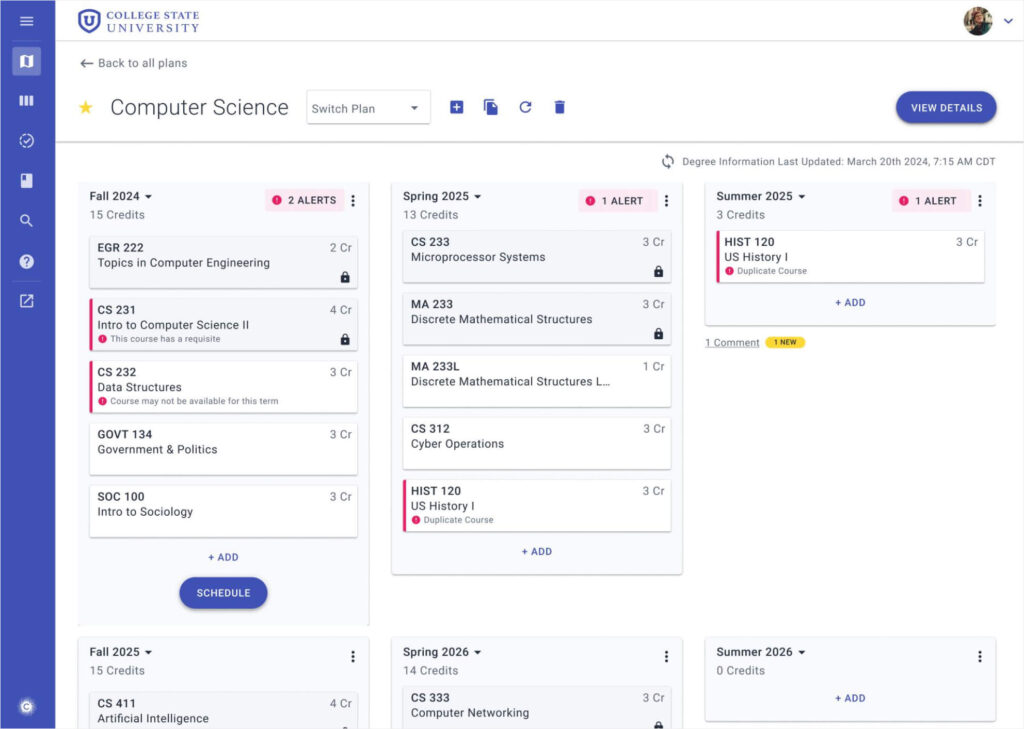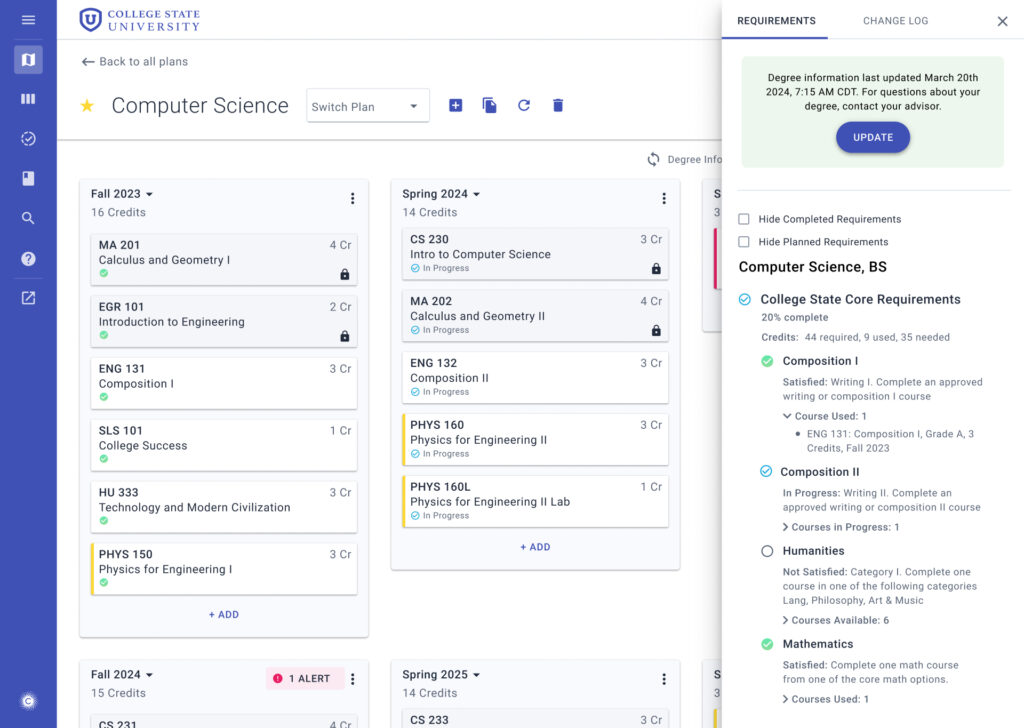
4 Ways a Connected Registration Experience Removes Barriers to Completion
Share this Post
Whether you are in a 4-year or 2-year institution, a variety of factors can complicate a student’s path to graduation. Surprisingly, many who delay their degree are near graduation. A Civitas Learning analysis found that one in five students finishes 75% of their degree before hitting pause.
The story behind this unfortunate statistic often boils down to students not knowing which classes they need, where to get help, and what steps lie ahead to get to the finish line. From understanding degree requirements to tracking progress to facing a disjointed registration experience, these challenges put students’ ability to persist or graduate on time at risk. In addition to lowering persistence rates, adding extra terms imposes a financial strain on students, which many cannot afford, while attrition leads to substantial revenue losses for institutions.
Despite this challenge, strategies are available to streamline these processes for students and staff. Below are four ways institutions are simplifying the path to graduation and making it easier for students to persist to the next term.
#1 Identify Barriers to Course Access on Students’ Degree Plan
Many institutions struggle to offer students an intuitive method for mapping their pathway to graduation. Understanding what steps are needed in the terms ahead to progress toward their degree can seem overwhelming, and finding a class schedule that fits the day-to-day logistics students juggle can be difficult. Moreover, barriers to retention, such as classes not offered in a certain term or conflicting courses, can lead students to under-enroll in courses or enroll in courses they don’t need to complete their degree.
With the ability to view a complete picture of a student’s progress toward their degree, Civitas Learning’s Academic Planning and Scheduling solution empowers students to personalize their plans and view progress toward their degree, providing a clear pathway to graduation. Advisors and students can access a detailed history of completed courses, including transfer credits, as well as a snapshot of earned credits, current credits in progress, and any course withdrawals or retakes, so they know what’s needed to complete their degree on time and within budget.
Within the planning solution, students and advisors receive plan alerts in real-time that proactively identify potential barriers such as:
- Duplicate courses
- Missing prerequisites and corequisites
- Courses that do not count toward degree requirements
- Courses not available for scheduling

#2 Allow Students to Take Ownership of their Degree Plan
It is common practice for advisors to manage the degree planning process, factoring in students’ preferences and handling course entries and modifications. While this strategy appears to be a good way to ensure students stay on track to graduate, it can decrease student engagement.
When institutions empower students to take ownership of their planning, with advisors available for guidance, student success significantly increases. With students in the driver’s seat, they can see exactly what is needed to progress and address any obstacles proactively, such as enrolling in courses that do not contribute towards their degree requirements.
A Civitas Learning impact analysis has uncovered that a student-driven planning process has a 6.9 percentage point lift on persistence. On top of this, student-centered course scheduling has resulted in a 6.3 percentage point boost in persistence. The feedback among institutions is consistently encouraging, and many observe a stronger connection between students, advisors, and the institution. For example, Ensign College reports that the ability to visualize degree plans and understand course sequencing has been transformative.

“Our students are really excited that they have a planning software that is simple to use and allows them to take ownership of their experience.”
— Erin Gunnell,
Director of Success Advising & Tutoring, Ensign College
#3 Discover Opportunities to Simplify the Registration Process
Like any shopping experience, moving from multiple platforms during registration often leads to an incomplete transaction (or registration). Typically, students consult a paper degree plan, map out their desired course schedule on a paper calendar, select courses within their Student Information System (SIS), and then proceed to register. Additionally, the manual effort required by advisors and registrars during and in preparation for registration can be overwhelming and distract from their ability to engage with students and understand their goals.
With Civitas Learning’s end-to-end planning and scheduling solution, students gain a clear path to graduation, improving their chances of graduating on time. They can monitor course progress and remaining requirements, minimizing confusion during registration. They can also plan, schedule, and register all in the same experience. When questions arise, students can easily seek guidance by communicating directly with advisors. Advisors, in turn, can address questions through plan comments, offer suggestions, and fix any planning errors to ensure students stay on track.
Additionally, institutions encounter inefficiencies in backend administrative processes since many follow a sequence that involves documenting notes outside the enrollment solution, manually inputting data, and making one-off adjustments. Civitas Learning’s solution integrates these processes seamlessly, preventing them from being inundated with manual data entry and adjustment requests.

#4 Enhance Opportunities for Guidance and Support
Streamlining the planning and registration experience clarifies the path to completion and enhances advising relationships, opening the door to providing more holistic support. Success in college extends beyond grades and demands a unified effort from the institution. Ensuring students feel a sense of belonging is pivotal to their decision to persist; however, achieving this becomes challenging when advisors and support staff are overburdened with requests.
Civitas Learning’s planning solution makes it easy for students to map out their path to graduation while simultaneously receiving guidance within the same experience. Advisors view the same plan as students, serving as a shared canvas. Advisors can facilitate collaboration by:
- Providing plan comments in real-time
- Editing academic plans on behalf of students
- Tracking changes in the change log
Advisors carry an average caseload of 300 students, making personalizing outreach and prioritizing support difficult. However, the planning solution addresses this challenge by enabling advisors to see the complete picture of their caseload. They can prioritize support for groups of students in need, such as those who have built schedules but still need to register.
For instance, the system can identify students in this category and prompt advisors to reach out with timely reminders or alternative options if necessary. This proactive approach streamlines communication and ensures students receive the support they need to stay on track.

“I can focus more on what will happen in the future than just focusing on a given semester. It’s more a visual tool to think ahead and adjust things in advance before it’s too late.”
— Leslie Abarr-Cuena,
Director of Student Success, Northwest Missouri State University
Smooth the Pathway to Graduation
Navigating the path to graduation poses significant challenges for students across all institutions. By recognizing and addressing barriers so students stay on track to persist to graduation, institutions can make success much easier to achieve. Civitas Learning’s end-to-end planning and registration platform is a key part of making this happen, providing the tools needed to simplify academic planning and registration and boost student success outcomes.
For more information on how student-centered planning improves outcomes, check out Civitas Learning’s solution here.

